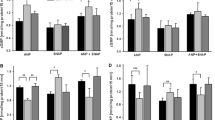Abstract
Focal glomerulosclerosis is the predominant glomerular lesion in heroin addicts. We studied whether morphine, a metabolite of heroin, could directly affect the formation of superoxide by glomerular mesangial cells. Mesangial cells preincubated with morphine (10−8 M) showed a higher (P<0.001) production of superoxide when compared to control cells (control) 401±21 vs. morphine 610±41 nM/mg protein/h). This effect of morphine on mesangial cells was dose dependent. Naloxone, an opiate antagonist, attenuated morphine-induced formation of Superoxide by mesangial cells [control, 317±4; morphine (10−8 M), 573±9; and naloxone (10−8 M) + morphine (10−8 M), 333±6 nM/mg protein/h]. We conclude that morphine enhances formation of superoxide by mesangial cells and this effect of morphine seems to be mediated through opiate receptors. Since superoxide has been demonstrated to cause mesangiolysis, we propose that morphine may be playing a role in the induction of mesangial injury in patients with opiate abuse.
Similar content being viewed by others
References
Rao, T. K. S., A. D. Nicastri, andE. A. Friedman. 1974. Natural history of heroin associated nephropathy.N. Engl. J. Med. 290:214–227.
Yamamoto, T., andC. B. Wilson. 1987. Quantitative and qualitative studies of antibody-induced mesangial cell damage in the rat.Kidney Int. 32:514–525.
Morita, T., I. Kihara, T. Oite, T. Yamamoto, Y. Suzuki 1978. Mesangiolysis. Sequential ultrastructural study of Habu venom-induced glomerular lesions.Lab. Invest. 38:94–102.
Stratta, P., C. Canavese, M. Dogliani, G. Monga, G. Mazzuco, R. Novarra, P. Vono, D. Gattulo, S. Beddino, G. Testore, andA. Vercellone. 1989. Experimental evidence for mesangiolysis due to hydrogen peroxide.J. Nephrol. 1:37–42.
Stratta, P., C. Canavese, G. Mazzucco, G. Monga, andA. Vercellone. 1989. Mesangiolysis and endothelial lesions due to peroxidative damage in rabbit.Nephron 51:250–256.
Schlondorff, D. 1987. The glomerular mesangial cell: An expanding role for a specialized pericyte.FASEB J. 1:272–281.
Sraer, J. D., C. Adida, M. N. Peraldi, E. Rondeau, andA. Kanfer. 1993. Species specific properties of the glomerular mesangium.J. Am. Soc. Nephrol. 3:1342–1350.
Neuwirth, R., P. Singhal, B. Diamond, R. M. Hays, L. Lobmeyer, K. Clay, andD. Schlondorff. 1988. Evidence of immunoglobulin Fc receptor-mediated prostaglandin E2 and platelet activating factor.J. Clin. Invest. 82:936–944.
Sedor, J. R., S. W. Carey, andS. N. Emancipator. 1987. Immune complexes bind to cultured rat glomeruli mesangial cells to stimulate superoxide release: Evidence for a Fc receptor.J. Immunol. 138:3751–3757.
Sharp, B. M., W. F. Keane, H. J. Suh, G. Gekker, D. Tsukayama, andP. K. Peterson. 1985. Opioid peptides rapidly stimulate superoxide production by human polymorphonuclear leukocytes and macrophages.Endocrinology 117:793–795.
Simantov, R., S. R. Childers, andS. H. Snyder. 1978. [3H]Opiate binding: Anomalous properties in kidney and liver membranes.Mol. Pharmacol. 14:69–76.
Dave, J. R., N. Rubinstein, andL. Eskay. 1985. Evidence thatβ-endorphin binds to specific receptors in rat peripheral tissue and stimulates the adenylate cyclase-adenosine 3′, 5′-monophosphate system.Endocrinology 117:1389–1396.
Mehrishi, J. N., andI. H. Mills. 1983. Opiate receptors on lymphocytes and platelets in man.Clin. Immunol. Immunopathol. 27:240–245.
Lopker, A., L. G. Abood, andW. Hoss. 1980. Stereoselective muscarinic, acetylcholine and opiate receptors in human phagocytic leukocytes.Biochem. Pharmacol. 29:1361–1365.
Singhal, P. C., A. Dreisbach, M. Abramovici, N. Gibbons, andN. Goyal. 1992. Mesangial cells express specific receptors for beta-endorphine.Nephron 62:66–70.
Brown, S. M., B. Stimmel, R. W. Taub, S. Kotchwa, andR. E. Rosenfield. 1974. Immunologic dysfunction in heroin addicts.Arch. Intern. Med. 134:1001–1006.
Tubaro, E., G. Borelli, C. Croce, G. Cavallo, andC. Santinageli. 1983. Effect of morphine on resistance to infection.J. Infect. Dis. 148:656–665.
Latta, H., andS. Fligiel. 1985. Mesangial fenestrations, sieving, filtration and flow.Lab Invest. 52:591–598.
Singhal, P. C., C. Pan, andN. Gibbons. 1993. Effects of morphine on uptake of immuno-globulin-G complexes by mesangial cells and macrophages.Am. J. Physiol. 264:F859-F866.
Singhal, P. C., G. Ding, S. DeCandido, N. Franki, R. M. Hays, andD. Schlondorff. 1987. Endocytosis by cultured mesangial cells and associated changes in prostaglandin E2 synthesis.Am. J. Physiol. 252:F627-F634.
Singhal, P. C., M. Abramovici, andN. Gibbons. 1992. Long term effects of morphine on mesangial cell proliferation and matrix synthesis.Kidney Int. 41:1560–1570.
Author information
Authors and Affiliations
Additional information
This work was supported by National Institute of Health Grant R01-DA-06753.
Rights and permissions
About this article
Cite this article
Singhal, P.C., Pamarthi, M., Shah, R. et al. Morphine stimulates superoxide formation by glomerular mesangial cells. Inflammation 18, 293–299 (1994). https://doi.org/10.1007/BF01534270
Issue Date:
DOI: https://doi.org/10.1007/BF01534270




